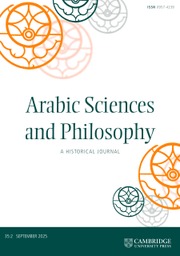Article contents
The Spherical Case of the Tūsī Couple
Published online by Cambridge University Press: 24 October 2008
Abstract
In this article we study the development of the mathematical theorem, now known as the Tūsī Couple, and discuss the difference between its plane and spherical applications.
Dans cet article, nous étudions le développement du théorème mathématique, connu maintenant sous le nom de ‘couple d'al-Tūsī’; et nous discutons la différence entre son application plane et son application sphérique.
- Type
- Research Article
- Information
- Copyright
- Copyright © Cambridge University Press 1991
References
1 Ragep, F. Jamil, “The Two Versions of the Tūsī Couple,” in From Deferent to Equant: A Volume of Studies in the History of Science in the Ancient and Medieval Near East in Honor of E.S. Kennedy, Annals of the New York Academy of Sciences, vol. 500 (1987), pp. 329–56.Google Scholar
2 Saliba, George, “The Role of the Almagest Commentaries in Medieval Arabic Astronomy: A Preliminary Survey of Tūsī's Redaction of Ptolemy's Almagest,” Archives Internationales d'Histoire des Sciences, 37 (1987): 3–20.Google Scholar
3 Described in detail in Saliba, “The Role of the Almagest.”
4 Nasīr al-Dīn al-Tūsī, Hall-i Mushkilāt-i Mu'īnīye, facsimile with introduction by Dānesh Pazẓūh, Dāneshgāh, Teheran, 1335 (1957).Google Scholar
5 See, for example, Kennedy, Edward S., “Late Medieval Planetary Theory,” Isis, 57 (1966): 365–378, p. 370,CrossRefGoogle Scholar and Saliba, George, “The Astronomical Tradition of Maragha: A Historical Survey and Prospects for Future Research,” Arabic Sciences and Philosophy: A Historical Journal, 1 (1991): 67–99.CrossRefGoogle Scholar
6 Nasīr al-Dīn al-Tūsī, al-Tadhkira, Leiden MS Or. 905, fol. 50v.Google Scholar
7 Especially in Qutb al-Dīn al-Shīrāzī, Nihāyat al-idrāk fī dirāyat al-aflāk, Istanbul, MS Köprülü 957, fol. 50v.
8 The work is described by El-Dallāl, Ahmad, The Astronomical Work of ṣadr al-Sharī'ah: An Islamic Response to Greek Astronomy, unpublished Ph.D. dissertation, Department of Middle East Languages and Cultures, Columbia University, 1990, pp. 320–26.Google Scholar
9 Nizām al-Dīn Hasan b. Muhammad al-Nīsābūrī, (1310), Tawdīh al-Tadhkira, Cairo, Dār al-Kutub, MS Hay'a 66, p. 190.Google Scholar
10 Qutb al-Dīn al-Shīrāzī, Fa'altu fa-lā talum, Teheran, Majlis-i Shurāy-i Millī, MS 3944, fols. 68r–68v.Google Scholar
11 Al-Sharīf al-Jurjānī, Sharh; al-Tadhkira al-Nasīrīya, Cairo, Dār al-Kutub, MS Hay'a 103, p. 108.Google Scholar
12 Fathallāh Shīrvānī, Sharh al-Tadhkira, Istanbul, Topkapi Seray, MS Ahmad III 3314, fol. 246r.Google Scholar
13 Muhammad b. Ahmad Al-Khafrī, al-Takmila fi Sharh al-Tadhkira, India Office Library, MS Loth 747, fol. 169r.Google Scholar
14 ‘Abd al-'Alī b.Muhammad b. al-Husain Al-Birjandī, Sharh mukhtaṣar al-hay’a, Cambridge University Library, MS Add. 3589, fol. 170.Google Scholar
- 14
- Cited by


